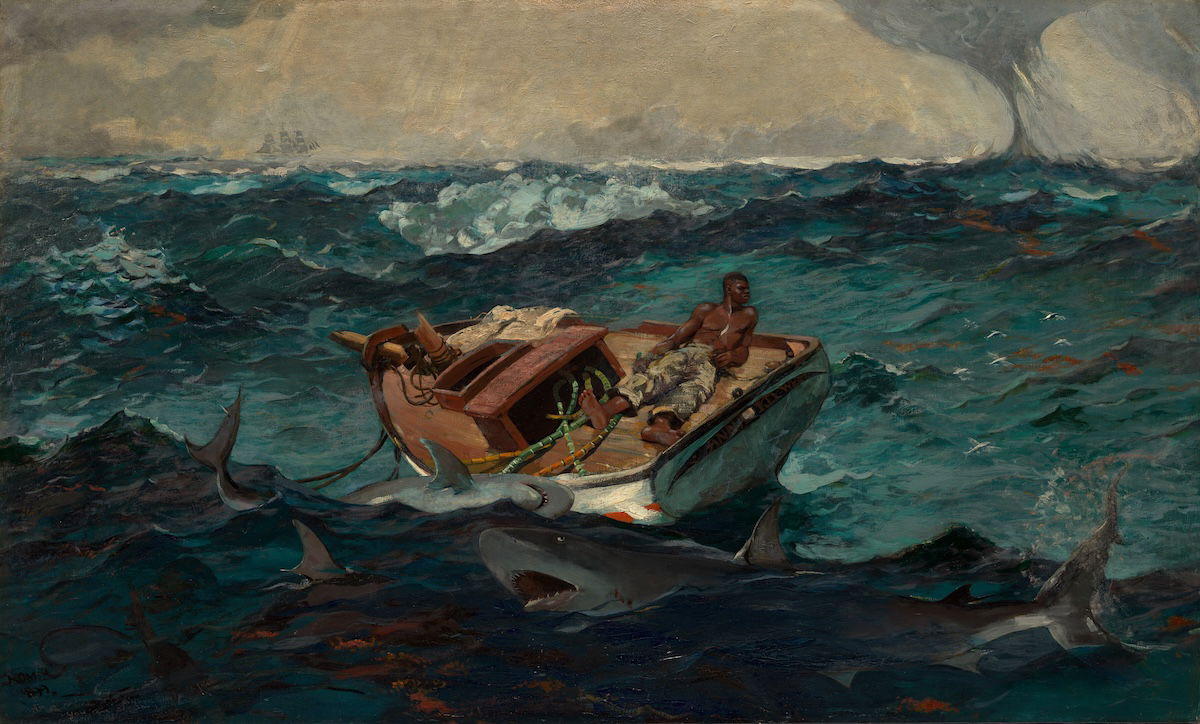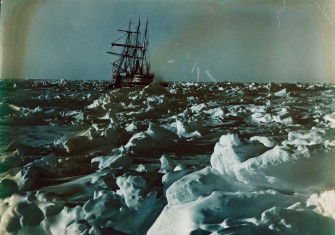‘Ocean’ and ‘Tracks on the Ocean’ review
Ocean: A History of the Atlantic Before Columbus by John Haywood and Tracks on the Ocean: A History of Trailblazing, Maps and Maritime Travels by Sara Caputo search beyond the swell.

Oceans inspire humans to ask big questions: what’s on the other side of the water? How can we cross it? What can we recover about those who have gone and failed to return? Two new books address these grand queries in different ways: Sara Caputo turns imaginatively to cartography, while John Haywood uncovers rich clues in archaeology and myth.
In his Ocean: A History of the Atlantic Before Columbus, Haywood makes clear that many societies have viewed the Atlantic as an impregnable barrier. Yet a small number of intrepid men (and a few women) ventured forth nonetheless. Haywood’s story unfolds in three phases, beginning 168,000 years ago. To explain prehistoric settlement patterns on all sides of the Atlantic, he provides a brisk overview of Pangaea, plate tectonics, and how Homo sapiens sapiens differed from (fair skinned, blue-eyed) Neanderthals across the Strait of Gibraltar. His early seaside dwellers eat grilled mussels in caves in the Western Cape of South Africa, while others at the tip of South America warm their bodies by small hearths. (That way of life persisted long enough to catch Ferdinand Magellan’s eye when he sailed through the icy southern strait in 1520; their fires inspired him to name the region ‘Tierra del Fuego’.)
A considerable amount of early human behaviour was shaped by the quest for food, and Haywood uses the remains of these meals as evidence for humans’ evolving relationship with the sea. Excavations of Mesolithic and later midden heaps reveal quantities of fish and seafood in the diets of some, but not all, of these coastal residents. As we hurtle through the centuries, we learn about each region’s specialty: Norwegian stockfish (cod), Hanseatic herring, Basque whale oil.
Religion also propelled people across the seas, from the peregrinatio (‘journey for the love of God’) of medieval Irish monks, to the steady flow of pilgrims to A Coruña and Santiago de Compostela in northwestern Spain. But the central, most detailed part of the book is devoted to a people who did not travel for religious reasons: the Vikings. Haywood has published extensively on Norse life and lore. Here, he provides a concise summary of the 11th-century push to settle Iceland and Greenland, the Viking raids that harried the British Isles and beyond from the 10th through 13th centuries, and the short-lived settlement in Vinland. No matter that the timber-lined turf shelters on a rocky promontory of what is now Newfoundland were occupied for less than a decade; Haywood accords them pride of place as the first European settlement in the Americas.
The book’s final section begins in 1402, which Haywood dubs the ‘birth year of European imperialism’. He relates the accomplishments of the Iberians – especially the Portuguese mariners inspired and funded by Infante Dom Henrique de Avis (‘Henry the Navigator’) as they pushed past the landmarks that had served as limits for the Phoenicians, Carthaginians, Romans, and Muslims. These efforts to expand in all directions, including to the Canary Islands, would provide the Iberians with early experience interacting aggressively with indigenous populations, and introducing forced labour for sugar cultivation.
Haywood is a gifted storyteller, but his tales are on somewhat thinner ice when he leaves the far north. The aim of the book is to dethrone Columbus from his triumphal position in the pantheon of explorers, something Haywood uses mythology as well as archaeological evidence to achieve. However, his efforts to present west African and Muslim mariners as equal participants in this history can feel cursory. Ocean focuses less on how mariners learned the technical details of long-distance sailing, and more on their motivations. In his view, the geographic features that gave seafarers the best opportunities to experiment with maritime technologies were bays, inland seas, and archipelagoes. These types of coastal training grounds, common adjacent to the North Sea, explain why northern Europeans set off westward with such confidence.
Haywood wants us to see Columbus not as a sui generis innovator but as heir to a 15th-century burst of activity, one motivated – like centuries of earlier oceanic exploration – by marine sustenance, slaves, and (possibly) religion. He closes by crediting Columbus’ less-vilified compatriot Amerigo Vespucci for ‘the leap of imagination’ that created the concept of the ‘New World’ at the turn of the 16th century, a key moment that also produced ‘the birth certificate of the modern Atlantic Ocean’.
In Tracks on the Ocean, Sara Caputo focuses on another imaginative leap, this one made by the anonymous sailors who, for long-forgotten reasons, decided to record their voyages as a line on their charts. In her inventive cartographic history, Caputo frames these tracks as conceptual tools as well as narrative ones. Sometimes ‘simple [and] unidirectional’, sometimes a ‘puzzling maze of pencilled lines’, they provoke discussions of celebrity, patriotism, secrecy, and surveillance.
Sometime after the voyages of Vikings and Columbus alike, the notion from the biblical Book of Wisdom that a ‘ship follows no path and leaves no signs’ was dramatically overturned. Why? Like Haywood, Caputo sees the ocean as a precipitating factor. Terrestrial journeys did not inspire their protagonists to trace out paths for the simple reason that roads already showed their progress. But in the 16th century, ‘ship tracks appear almost out of nowhere’.
Caputo analyses a series of intriguing maps, including the 14th-century Hereford Mappa Mundi, a 1580 Mexican map marked with a trail of small footprints, and the pamphlets given to modern cruise passengers so that they might mark their own progress along the liner’s route. For oceanic navigators, voyage tracks began as a useful direction-finding tool but soon morphed into something more complex. They often represented a claim to primacy, important as trade routes acquired legal value from the 16th century onward. Tracks were also used to glorify bold adventurers – whether they returned home safely or not. Sailors benefited from sticking to well-travelled, safer routes. But those who wished to carve out a space for themselves on their empire’s maps needed to venture into riskier, unfamiliar territory.
A track often represents an idealised voyage – the well-ordered chart made by a Royal Navy officer, the ostensibly direct route of a steamship. The reality, of course, is not as simple as the tracks would have us believe. As visual representations, lines are not bound by language – yet they can still evoke national pride. They can project expertise but also mystery. While lines on maps were typically made by their protagonists, during the Second World War the effort to hunt down German U-Boots turned these tracking efforts into tools of surveillance. Human tracks on the oceans are increasingly indelible – from underwater telegraph cables to the Suez Canal.
In her thought-provoking final chapter, Caputo celebrates the subversive power of those track-makers who are usually omitted from historical accounts: the ship captain’s daughter who deftly computes the daily position; the Polynesian navigator who conceives of his ship as stationary while islands move around him. These ‘counter-tracks’ make visible the tension between remembrance and mortality, and between ‘movement apparently free but in truth guided and channelled’. Caputo asks her readers to consider what it means to be tracked by the satellites that guide – and monitor – our smartphones. Ultimately, it remains unclear if these cartographic paths are ‘thin personal lines or the infrastructure of all universal knowledge’. Although Caputo leaves us with more questions than answers, the track along which she guides us is a fascinating one.
-
Ocean: A History of the Atlantic Before Columbus
John Haywood
Apollo, 432pp, £30
Buy from bookshop.org (affiliate link) -
Tracks on the Ocean: A History of Trailblazing, Maps and Maritime Travels
Sara Caputo
Profile, 320pp, £30
Buy from bookshop.org (affiliate link)
Margaret E. Schotte teaches at York University, Toronto and is the author of Sailing School: Navigating Science and Skill, 1550-1800 (Johns Hopkins University Press, 2019).






